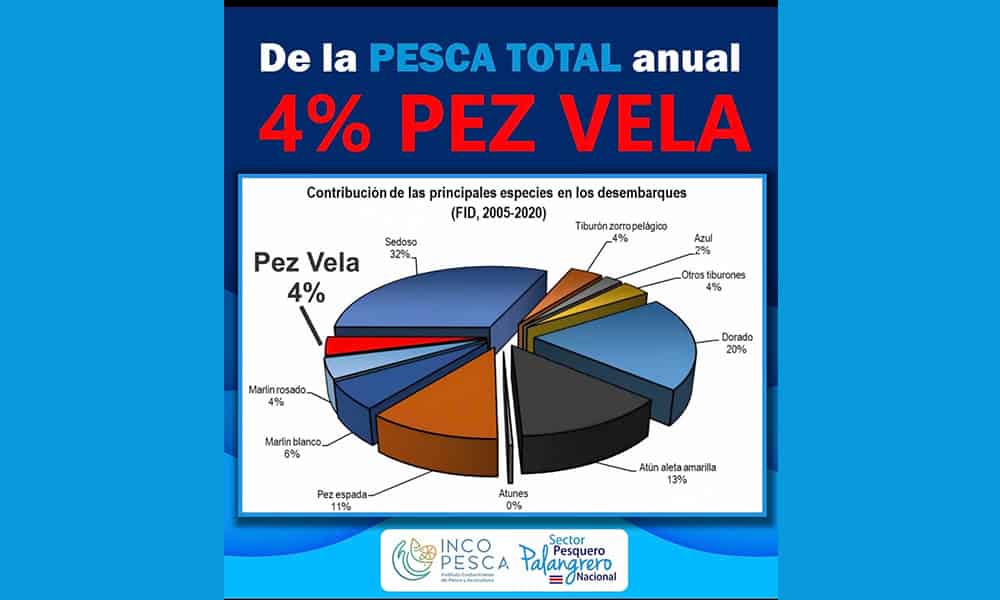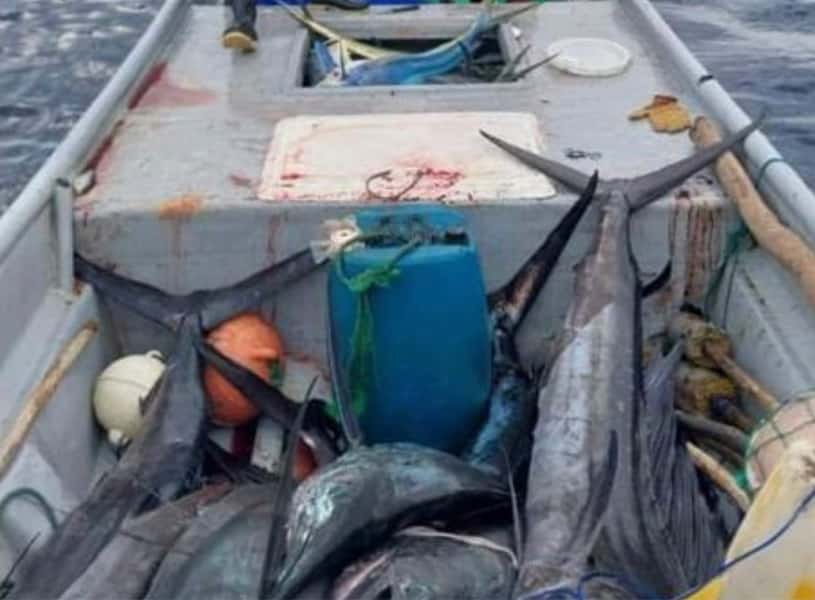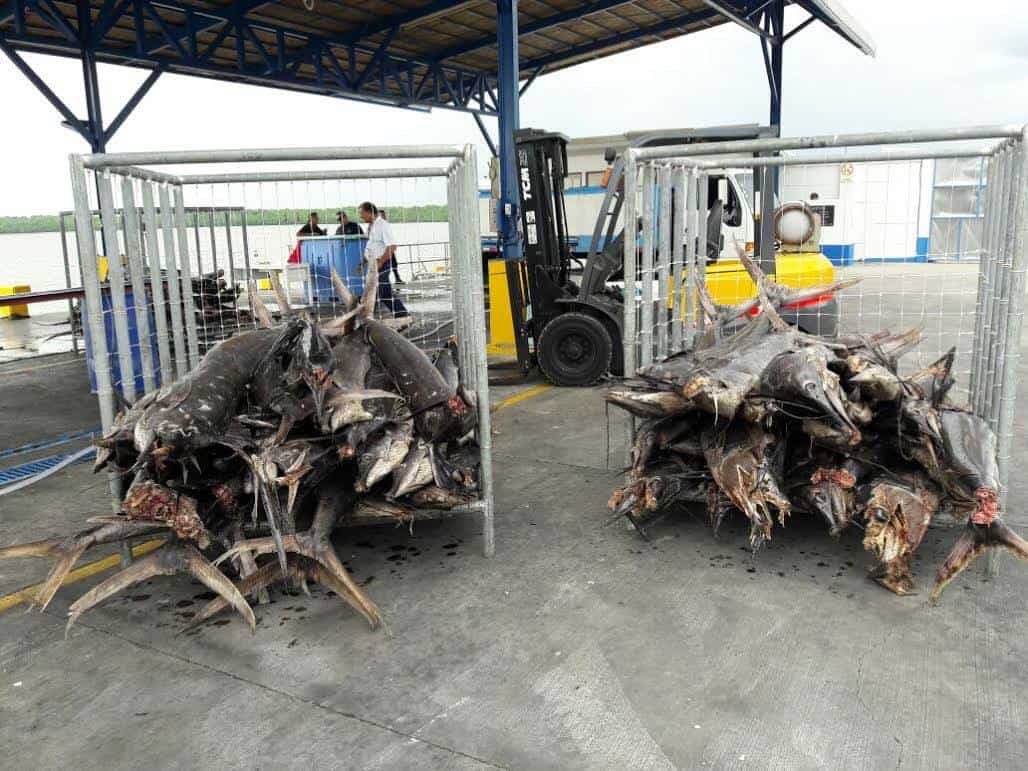FECOP’s first major accomplishment was the creation of the largest Marine Responsible Fishing Area in Central America, the Golfo Dulce. FECOP’s first President worked tirelessly in the effort and suggested that only inside the gulf, all treble hooks on lures be replaced with single hooks.
The Central American representative of an International Billfish NGO, who is also Costa Rican did not agree and talked his organization into supplying studies that could oppose the treble hook ruling even though they advertise as the only NGO dedicated solely to billfish.
They submitted studies to INCOPESCA that showed the survival rate was not affected by treble hooks. The difference being the studies were done with relatively small fish, (Artic char and grayling) that could be easily held in one hand while the hooks were removed with the other. The fish caught in the Golfo Dulce are much larger and often swallow the entire lure.
Later the President of FECOP at that time was at a meeting and made the statement that fishing tournaments should be regulated to all areas of the country because Herradura and Quepos had all the tournaments, and none were in Northern or Southern Costa Rica. He also stated that tournaments should have observers on board and possibly limit the number of fish per boat. It was a personal opinion, not one of FECOP.
The Central American representative of the NGO, who was in a personal war with this member reported it to the powers that be and they and another international NGO, that puts on tournaments, sent out newsletters to all their members asking for donations to fight the “quasi green environmentalists” masquerading as sport fishermen and were against tournaments. I’m sure that the NGO and Central American representative were still angry about recently losing the thousands of dollars they had been receiving annually through FECOP.
For the last decade, people from the Central Pacific Association group have been taking hits at FECOP. Mostly with mis-information campaigns like the urgent letter I highlighted in Part 1, stating that sport fishermen and charter captains would not be able to fish for sailfish if the bill was passed.
Congressman Eli Feinzaig
Congressman Eli Feinzaig who submitted the new bill for discussion sent out the following statement to correct the groups’ inaccuracies.
“I’m Eli Feinzaig and I’d like to refute certain rumors and clarify certain fears concerning the bill I have introduced declaring the sailfish as a national symbol. In the first place, it has been mistakenly said that if it were declared a national symbol, it would be untouchable because it would receive absolute protection, and this would stymie sports, tourist, and commercial fishing. This is completely false. The national symbol category selected is that of national symbol for economic development.
It is the same category granted to coffee when it was declared a national symbol. And it is also wrong to think that, when declared a national symbol, there is absolute protection. Chirripó National Park, the Crestones area, which is the area where people enjoy climbing, was declared a national symbol precisely to promote tourist activities.
The other issue is that there is fear that, when saying that sailfish fishing is banned to commercial fishing, it may be interpreted that commercial fishing includes tourist and sports fishing. This is not so because it has been defined in many statutes, particularly in the Fishing and Aquaculture” In any case, I’ll be filing a motion to amend the wording so that it is absolutely clear that catch-and-release fishing will be allowed within the set of protections that the sailfish population may receive.”
Central Pacific Association for Sport Fishing and Tourism
The Central Pacific Association for Sport Fishing and Tourism latest press release published May 19th in the La Republica sounds like something directly out of the INCOPESCA play book. That could be because two of their consultants are former Directors of INCOPESCA and a third is a board member representing sport fishing. This one was once a member of FECOP who wanted to be President of FECOP.
When it was discovered the Association, they represented had expired making them ineligible to serve, they angrily resigned from FECOP and have had an axe to grind ever since.
Mr. Espinoza,
Your press releases no longer expressed the misinformation you shared in the first letter you sent out. So let me address the things in your current press release.
La Republica
One of the complaints is that they (Central Pacific Association for Sport Fishing and Tourism) have not been invited to participate in the preparation of the proposal and that there has been a campaign that it is a benefit for tourist fishing, when they consider it not so.
FECOP met with Los Suenos staff and discussed trying to ban the sale of sailfish. That is basically meeting with the same group of people as Central Pacific. They all agreed with banning the sale of sailfish. We asked for a meeting with the Marina Association over a month ago and two of Los Suenos employees represent the Marina Association on the INCOPESCA sport fishing commission and have yet to get a meeting scheduled.
FECOP has active social media and website as well as several chat groups we keep anyone interested in knowing what we are doing. We also post the results of our studies there. Your social media hasn´t been touched in 7 years. That won´t get you a passing grade in communication.
Your group has repeatedly said we did not invite you to an event we organized in San Jose when what we said was you can bring two people like everyone else, not five as you requested. No-one from your group showed and someone did their best from afar to sabotage our event. Even so, it went off well.
Two days later we met with the fishermen in Herradura and again no–one from your group showed and another sabotage attempt was made by boats on radios spreading untruths and asking local fishermen to boycott our meeting.
That’s some great cooperation on your group’s part. As far as your working with your particular group it is like this. If someone has a dog and every time the dog comes home, they kick it, eventually the dog doesn’t come home.
Your Press Release
La Republica
Lack of studies in the scientific and socioeconomic part. The data used is not correct and some legal inconsistencies, are part of the indications to the project.
Data exists
Dra. Marina Marrari is a marine biologist and data expert who is currently Executive Director of FECOP, She has done extensive studies and published papers on both the commercial and sport fishing sectors related to sailfish in Costa Rica.
She analyzed over 10,000 sport fishing trips in Costa Rica as well as over a decade of commercial landings of billfish.
While catch and release rates for sport fishermen have decreased as much as 70% since 2010, commercial landings have reported an increase of dead sailfish brought to port by as much as 126% for the same time period. Considering almost half of the body weight is discarded in the ocean and only “trunks” are brought to port, it is estimated somewhere between 16,000 sailfish or more are killed annually in Costa Rica
Dra Marrari presented her study to the INCOPESCA board of directors and then Vice Minister of Agriculture Monge. Mr. Monge then ordered the Board of Directors to have Dra. Marrari present her data to the scientific committee of INCOPESCA who makes recommendations to the board based on science. They hold a lot of weight with decisions affecting marine resources.
Over a year later, the new Minister of INCOPESCA has yet to schedule her presentation before the scientific committee despite several requests. In this case the science is there. They just seem to not want the INCOPESCA Scientific Committee to see it.
While the presentation to the Scientific Committee has been stalled, her work was submitted to be PEER reviewed. (Peer review is a fundamental part of scientific publishing whereby individuals with relevant expertise who were not involved in a particular piece of research critically appraise others’ work to ensure that it meets standards for ethical conduct, quality, and rigor.) Her work passed with flying colors and has since been published in the prestigious science journal Frontiers in Marine Science.
My Question
What information do you have to accuse it of being inaccurate?
I learned a long time ago INCOPESCA will stall things based on, “lack of studies or evidence”. That is why we have some of the best scientists in the country on our staff now, and plenty of other members with years of fishing experience to share their opinions.
When one of your consultants was Director of INCOPESCA I tried to make a complaint of longliners using live bait in a restricted zone. I was told to bring evidence. This was before every cell phone had a video camera so I took photos of the bait and GPS coordinates. When I presented it to him, he said, “I can’t tell from this photo whether the bait is alive or dead.” I replied, Sir I don’t know anyone who bridles a dead bait!”
INCOPESCA recently got a taste of its own medicine when they requested a list of several hundred species to be marketed including turtles and iguanas. The congress balked and asked them to produce their scientific study. INCOPESCA was forced to withdraw the request. Several NGOs have since asked for the Minister of INCOPESCA be removed.
Let´s see what kind of rumor can get started here. FECOP, collaborated with MarViva, and Widecast and published a 66-page report on long line fishing in Costa Rica. The report can be downloaded on the FECOP website at FINAL-pesca-palangre-17-05-21-1-1.pdf (fishcostarica.org) Sorry it is only available in Spanish.
We don’t always agree with Marviva or Widecast but rather than treat each other as enemies we treat each other with respect and can work together on projects of mutual interest. It saves everyone involved time and money and is much better use of donor´s money than spending it on repeating studies or non-productive fighting.
La Republica
“If this law is approved, it would seriously affect the country´s tourist and sport as a great source of employment,” said Daniel Espinoza representative of the Central Pacific Sport Fishing and Tourism Association.
Absolutely it would. For the positive. If sailfish recovered as tuna has, it would be great for everyone. Tourists wouldn’t be looking at other destinations because the number of sailfish has dropped miserable here over the years. All your group is doing is punching down on FECOP. You know sailfish are in serious trouble.
You have yet to mention a solution. The only thing I have heard from your direction is a continuation of some regulations that are unenforceable but may calm the masses to hear again. Those are discussed it the 66-page longline report and why they never worked.
La Republica
In addition they warn that communities and families dependent on this activity are being put at risk
Please explain this one. How can more sailfish available for the tourist sport fishing sector put coastal communities at risk?
Everyone seems to forget the Costa Ricans that work on the boats and the other jobs created in coastal communities. Many in the marinas are lucky enough to have year-round employment for them. The majority of others have 5 months a year during the season and must seek other work in the off season.
Even though you advertise as the Sailfish Capital of the World, the reality is Guatemala took that from Costa Rica years ago. How? They banned the sale of sailfish. The numbers are so high at times there now the fishermen themselves voluntarily given up using dredges as fish attracting devices.

INCOPESCA claims only 4% of the longline fleets landings is sailfish. 4% is nothing to surrender. Of course that number is suspect but still adds up to at least 16,000 sailfish a year.
What is interesting about the graph is blue marlin, the most prevalent of marlin here in Costa Rica is notably absent from the graph.

I have unjustly put all blame on the decline of sailfish on the medium and advanced longline fleet. The artisanal fleet is also fishing with longlines and targeting sailfish with live-bait. They are only licensed to fish within 3 miles of the beach and they sneak out further. Many of these fish are landed with no inspection so the actual number of sailfish killed each year in Costa Rica is startling.
The ONLY way to have a recovery of sailfish like we have seen with recovery of yellowfin tuna is to ban the sale sailfish all together. If not the overfishing, underreporting, illegal fishing, illegal sales, purchases, and transportation will continue. Only when it is illegal to bring them to shore will they begin to recover and Costa Rica has so much more to offer tourists than Guatemala and we can honestly regain the title as The Sailfish Capital of the World.
Mr. Espinoza, In your last two communications with the public, you have not addressed the problem, or offered a solution. All you have done is bash FECOP. For Christ´s sake, we are all supposed to be on the same team. Sailfish are in trouble but can recover nicely. It has already been proven with tuna, marlin, and dorado.
What I have learned from managing large groups of people, and over the years, and I have had nearly 1000 employees, is this culture is very effective at manipulating people or gathering information with rumors. These rumors almost always come with a tag line that says, “I can’t tell you where I heard it because I promised them I wouldn’t.” Even some Ex-Pats have acquired this technique quite effectively.
What my employees quickly learned is that when someone tells me a rumor, before I make an opinion or act on it or even worse repeat it, I listen to them and then I talk to the person the rumor is about. This cut my rumors way down while earning the respect of my employees who describe me as a strict but fair boss.
I have heard some rumors of what your group’s real motive for these communications of yours are that do not address the problem or a solution. Before I spread that rumor. I will give you a chance to explain it.
At the end of the day, we only need to answer to the man in the mirror. I suggest all of us pause for a moment and take a good look in the mirror.
It is sad when conservation groups throw rocks at each other for ego, credit, or competition for donors. At the end of the day the credit is not important. Reaching the goal is. The goal is saving our sailfish.
In case you missed Part 1 and are interested you can find it here:
The Dirty Business of Costa Rica Conservation……. Part One : (ticotimes.net)






